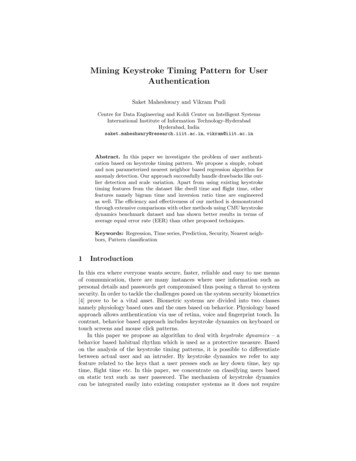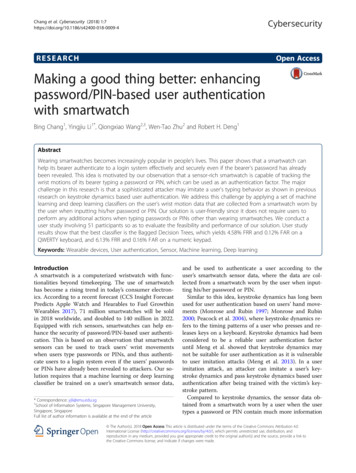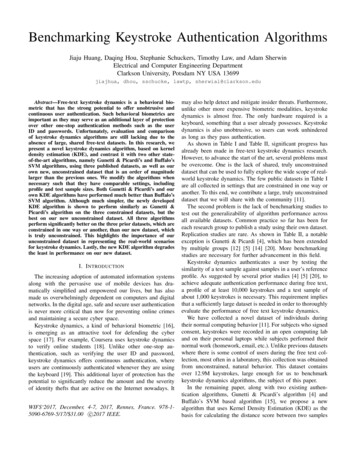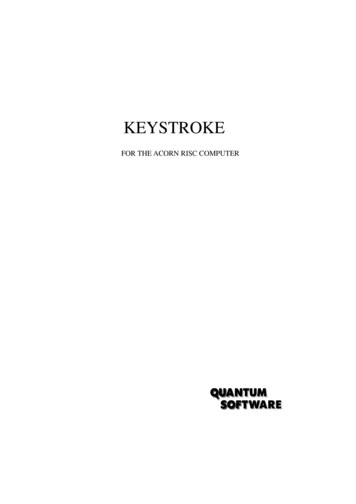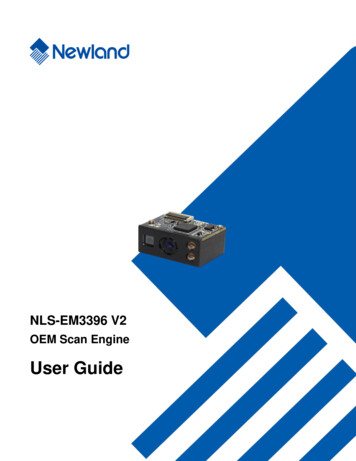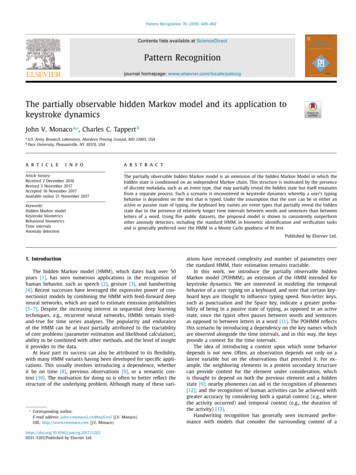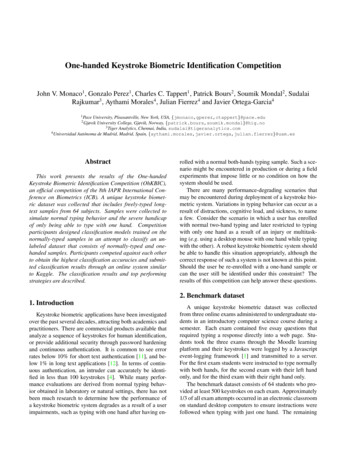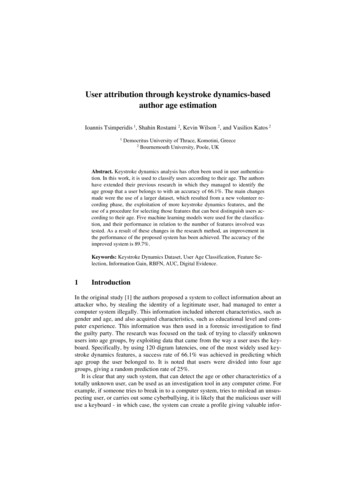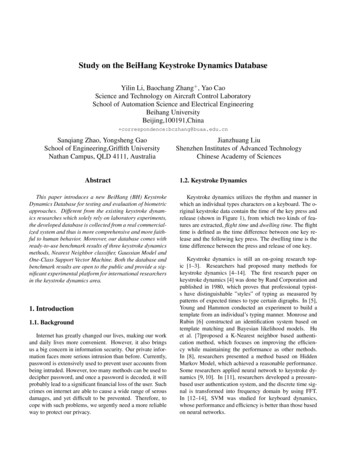
Transcription
Study on the BeiHang Keystroke Dynamics DatabaseYilin Li, Baochang Zhang , Yao CaoScience and Technology on Aircraft Control LaboratorySchool of Automation Science and Electrical EngineeringBeihang UniversityBeijing,100191,China correspondence:bczhang@buaa.edu.cnSanqiang Zhao, Yongsheng GaoSchool of Engineering,Griffith UniversityNathan Campus, QLD 4111, AustraliaAbstractThis paper introduces a new BeiHang (BH) KeystrokeDynamics Database for testing and evaluation of biometricapproaches. Different from the existing keystroke dynamics researches which solely rely on laboratory experiments,the developed database is collected from a real commercialized system and thus is more comprehensive and more faithful to human behavior. Moreover, our database comes withready-to-use benchmark results of three keystroke dynamicsmethods, Nearest Neighbor classifier, Gaussian Model andOne-Class Support Vector Machine. Both the database andbenchmark results are open to the public and provide a significant experimental platform for international researchersin the keystroke dynamics area.1. Introduction1.1. BackgroundInternet has greatly changed our lives, making our workand daily lives more convenient. However, it also bringsus a big concern in information security. Our private information faces more serious intrusion than before. Currently,password is extensively used to prevent user accounts frombeing intruded. However, too many methods can be used todecipher password, and once a password is decoded, it willprobably lead to a significant financial loss of the user. Suchcrimes on internet are able to cause a wide range of serousdamages, and yet difficult to be prevented. Therefore, tocope with such problems, we urgently need a more reliableway to protect our privacy.Jianzhuang LiuShenzhen Institutes of Advanced TechnologyChinese Academy of Sciences1.2. Keystroke DynamicsKeystroke dynamics utilizes the rhythm and manner inwhich an individual types characters on a keyboard. The original keystroke data contain the time of the key press andrelease (shown in Figure 1), from which two kinds of features are extracted, flight time and dwelling time. The flighttime is defined as the time difference between one key release and the following key press. The dwelling time is thetime difference between the press and release of one key.Keystroke dynamics is still an on-going research topic [1–3]. Researchers had proposed many methods forkeystroke dynamics [4–14]. The first research paper onkeystroke dynamics [4] was done by Rand Corporation andpublished in 1980, which proves that professional typists have distinguishable ”styles” of typing as measured bypatterns of expected times to type certain digraphs. In [5],Young and Hammon conducted an experiment to build atemplate from an individual’s typing manner. Monrose andRubin [6] constructed an identification system based ontemplate matching and Bayesian likelihood models. Huet al. [7]proposed a K-Nearest neighbor based authentication method, which focuses on improving the efficiency while maintaining the performance as other methods.In [8], researchers presented a method based on HiddenMarkov Model, which achieved a reasonable performance.Some researchers applied neural network to keystroke dynamics [9, 10]. In [11], researchers developed a pressurebased user authentication system, and the discrete time signal is transformed into frequency domain by using FFT.In [12–14], SVM was studied for keyboard dynamics,whose performance and efficiency is better than those basedon neural networks.
Figure 1. The dwelling time and flight time of keystroke dynamics.1.3. Keystroke DatabaseSimilar to other biometrics techniques, databases arevery important to researches in the field of keystroke dynamics. However, to the best of our knowledge, there is noopen keystroke dynamics database from a real commercialized system, while the benchmark databases in other biometrics problems are generally ample. For example, theFERET and FRGC databases are commonly used in facerecognition [15, 16]. In Palmprint recognition, the PolyUdataset [17]is the open platform for comparative evaluationof different algorithms.The aim of database is to allow different researchers totest their own algorithms based on the same dataset. In thesame experimental environment, the comparison betweendifferent algorithms would be more reasonable. In [4], researches on the keystroke dynamics were based on a longtext. Several people were asked to type a same paragraphof words. These experiments can prove the uniqueness ofkeystroke behavior; however, they could not be used for thepractical application.It should be noted that most of the previous experimentscollected the test samples in pure laboratory context [14].Therefore those datasets cannot represent a more generalsituation. So creating an open and comprehensive databasefrom a commercialized system for keystroke dynamics becomes a very important issue.The rest of the paper is organized as follows. In Section2, we describe the commercialized keystroke dynamics system used to establish the proposed database. The details ofthe BH Keystroke Dynamics database and benchmark experiments are introduced in Sections 3 and 4, respectively.Section 5 gives some discussions with future work.2. The Keystroke Dynamics systemIn this section, we introduce the preprocessing, featurereduction and benchmark recognition methods used in thecommercialized keystroke dynamics system.2.1. Preprocessing ProcedureSupposed a password is represented by the followingvector:P1 , R1 , P2 , R2 , ., Pn , Rn(1)where Pi and Ri represent the press and release time ofthe i th keystroke of a password. The elements of thefeature vector extracted from original keystroke informationare classified into two categories: dwelling time and flighttime. The dwelling time is calculated by Ri Pi , and theflight time is calculated by Pi Ri 1 , Pi Pi 1 , Ri Ri 1 .Therefore, the extracted feature from the original vectoris represented as:F (R1 P1 , P2 R1 , P2 P1 , R2 R1 , R2 P2 , .,Pn Rn 1 , Pn Pn 1 , Rn Rn 1 , Rn Pn )(2)The number of the registration samples collected in thetraining procedure is 4 or 5, which is not enough to get aneffective model. So we augment the training set by usingthe mean sample of each pair of samples.2.2. Feature reduction by varianceIn the registration procedure, to collect the trainingdataset, some key press or release events may suffer fromunpredicted disturbance, and so it may bring noise to thetraining process. Therefore, feature reduction is a very important step towards a system with a high performance. Inthis study, the variance is considered as the selection criterion to select features which can eliminate the noise fromtraining dataset. The feature extracted in the preprocessing procedure is represented by F . For each element Fi, we calculate its variance V ari , and a threshold (e.g.V ari 0.1 ) is used to decide whether the dimension canbe reserved.2.3. Benchmark Recognition MethodsSupport Vector Machine (SVM) is the state-of-the-artclassifier in machine learning. One Class SVM (OC-SVM)as a variant of SVM can train a classification model fromone class without negative samples. OC-SVM can also beviewed as a regular two-class SVM where all the trainingdata lie in the first class. The keystroke dynamics is basically a single-class problem, while in this paper we exploitthe nonlinear version of OC-SVM algorithm which mapsthe input data into a high dimensional feature space (via akernel) as our first benchmark algorithm. It should be not-
ed that OC-SVM is also one of the state-of-art methods inkeystroke dynamics.We also exploit Nearest Neighbor (NN) classifier as oursecond benchmark algorithm on the collected database. Inthe NN classifier, the Euclidean distance is used as the measure with given threshold for final classification.In probability theory, the Gaussian distribution is a continuous probability distribution that is often used as a firstapproximation to describe real-valued random variables thattend to cluster around a single mean value. We supposethat the keystroke data follow Gaussian distribution, therefore we can build a Gaussian model using the training data.This model is used as our third benchmark algorithm forkeystroke dynamics authentication in the format of the following Gaussian probability:p(x) 11exp{ (x µ)T Σ 1 (x µ)} (3)22π d/2 Σ 1/2where x is the test sample with Σ, µ as the covariance matrixand the mean vector of the Gaussian model, respectively.3. The BH Keystroke Dynamics DatabaseWe have collected a database by using a commercializedsystem on keystroke dynamics. It can be used by differentresearchers to test their algorithms and can eventually boostthe development of keystroke dynamics.3.1. Data collectionGenerally, several kinds of methods are used to capturethe keystroke event. The kernel based method is very powerful and can gain any information typed on keyboard as itreaches the operation system. However, the synchronization problem is not well solved in multi-kernel computers,though it is really effective and difficult to be detected byuser-mode applications in the single-kernel computers. Another widely used method is based on the HOOK keyboardAPIs. It includes a series of functions which reveal the status of key press or release event. However, the HOOKfunction is generally based on a lot of APIs which can leadto an increase in CPU usage. There are also some methods based on web browsing, but they are not secure as other methods in keystroke event detection. To deal with theabove problems, we design an instance stream to capturethe key press and release events as shown in Figure 2. Theproposed method is effective since the instance stream canbe a complement to the traditional HOOK function.A commercialized system following the above workprinciple was deployed to different environments, such asinternet bars and laboratories. It involved a variety of individuals whose registration and log-in keystroke informationwas collected. Each user was asked to type in his/her username for one time and his/her password for 4 or 5 times inFigure 2. Flowchart of the keystroke dynamics systemorder to create a new account. Some false data from users’misuse of the system were included in the primary dataset.By using a filter, those error data were abandoned and finally we got our BH database.3.2. Description of DatabaseThe BH database includes 2057 test samples and 556training samples from 117 subjects. The whole database isdivided into two subsets, Dataset A and Dataset B, collected from two different environments. DatasetA was collected in cybercafe environment. The commercial system wasembedded into the login system of an online game. DatasetB was collected online. The commercial system is opento the public. Each subject includes registration data fromgenuine users which is used as training samples, log-in data from genuine users and log-in data from intruders. Thethree sub-directories are named as ”training set”, ”positiveset” and ”negative set”, respectively. All the data are storedin text format.4. Expermental resultsIn this section, we present the benchmark experimentalresults of three kinds of keystroke dynamics methods conducted on the BH database.4.1. Evaluation CriteriaIn the experiment, we use False Positive Rate and TruePositive Rate for evaluation. The False Positive Rate is thepercentage of intruders who can enter the account by imitating the typing manner of genuine users. The True Positive Rate is the percentage of genuine users who can successfully login the system with right keystroke manner. Bychanging the threshold in the classification procedure, weget a series of True Positive Rate and False Positive Rate,and then we use these results to draw a ROC curve. TheROC curve is used for evaluation of an algorithm. Besidesthese two indicators and the ROC curve, we also use theEqual Error Rate to compare the performance of differentmethods. The Equal Error Rate is the percentage where the
Figure 3. Comparison of the ROC results of the three methodsbased on BH Dataset A.Figure 5. Comparison of the ROC results of the three methodsbased on BH Dataset B.Figure 4. Comparison of different prepossessing methods based onBH Dataset A.Figure 6. Comparison of different prepossessing methods based onBH Dataset B.False Positive Rate equals the False Negative Rate.5. Conclusion and Future Work4.2. Experimental ResultThe BeiHang keystroke dynamics database is open topublic use. Interested researchers may send a request tothe corresponding author. It can be found at two Chinesewebsites: http : //www.microdone.cn/balletl ogin.phpand http : //www.u1ge.com/help/passdancer.Our future work will focus on collecting a much largerdatabase. The proposed keystroke dynamics system has already been commercialized, but we plan to test other newmethods as well.In Figure 3 and 4, we display the experimental results of OC-SVM, Gaussian Model and NN classifier obtainedfrom BH Dataset A and Dataset B, respectively. It can beseen from the ROC results on the figures that the performance of OC-SVM is better than the Gaussian Model andNN classifier.We also tested different methods which are discussed insection 2.1 and 2.2 in the preprocessing procedure and theresults are shown in Figure 5 and 6. The experimental results of the Equal Error Rate is shown in Table 1 to comparethe performance of different methods. A similar conclusionas in Figure 3-6 can be observed.AcknowledgementsThis work was supported in part by the Natural Science Foundation of China, under Contracts 60903065
11.832726.6014EER/%DataBase ADataBase le 1. Equal Error Rate result based on different preprocessing methods.and 61039003, in part by the Ph.D. Programs Foundation of Ministry of Education of China, under Grant20091102120001, in part by the Fundamental ResearchFunds for the Central Universities, and in part by ShenzhenKey Laboratory for Computer Vision and Pattern Recognition.References[1] Fabian Monrose, Michael K. Reiter, and Susanne Wetzel.Password hardening based on keystroke dynamics. In International Journal of Information Security, volume 1, pages69–83, 2002.[2] R Joyce and G Gupta. Identity authentication based onkeystroke latencies. Communications of the ACM, 33(2),1990.[3] MS Obaidat and D T Macchairolo. An on-line neural network system for computer access security. IEEE Trans.Industrial Electronics, 40:235–241, 1993.[4] R.Gaines, W.Lisowski, S.Press, and N. Shapiro. Authentication by keystroke timing: some preliminary results. Technical report, Rand Corporation, 1980.[5] J.R. Young and R.W. Hammon. Method and apparatus forverifying an individual’s identity. Patent No. 4,805,222, U.S.Patent and Trade, Mark Office, 1989.[6] F. Monrose and A.D. Rubin. Keystroke dynamics as a biometric for authentication. Future Generation Computer Systems, pages 351–359, 1980.[7] J. Hu, D. Gingrich, and A. Sentosa. A k-nearest neighborapproach for user authentication through biometric keystrokedynamics. In Proceedings of IEEE International Conferenceon Communications, pages 1556–1560, 2008.[8] Ricardo N.Rodrigues et al. Biometric access control throughnumerical keyboards based on keystroke dynamics. In Proceedings of the International Conference on Biometrics,pages 640–646, 2005.[9] Daw-Tung Lin, Chung-Hua, and Hsinchu. Computer-accessauthentication with neural network based keystroke identityverification. Internaltional Congerence on Neural Networks,1997.[10] M.S. Obaidat and D.T. Macchairolo. A multilayer neural network system for computer access security. In IEEE Transactions on Systems, Man and Cybernetics, pages 806–813,1994.[11] Chen Change Loy, Dr. Weng Kin Lai, and Dr. Chee PengLim. Development of a pressure-based typing biometricsuser authentication system. ASEAN Virtual InstrumentationApplications Contest Submission, 2005.[12] E. Yu and S. Cho. Keystroke dynamics identity verification:its problems and practical solutions. Computers and Security, 23:428–440, 2004.[13] Y. Sang, H. Shen, and P. Fan. Novel impostors detectionin keystroke dynamics by support vector machine. Paralleland Distributed Computing:Applications and Technologies,pages 666–669, 2005.[14] Romain Giot, Mohamad El-Abed, and Christophe Rosenberger. Greyc keystroke: a benchmark for keystroke dynamics biometric systems. In IEEE International Conference onBiometrics: Theory, Applications and Systems, 2009.[15] P. J. Phillips, H. Moon, P. J. Rauss, and S. Rizvi. The feret evaluation methodology for face recognition algorithms.IEEE Transactions on Pattern Analysis and Machine Intelligence, 22(10), October 2000.[16] Hoffman, J. Marques, J. Min, and W. Worek. Overview ofthe face recognition grand challenge. Proc. Computer Visionand. Pattern Recognition, 2005.[17] Biometric Research Centre at The Hong Kong Polytechnic University, http://www.comp.polyu.edu.hk/ biometrics/.PolyU Palmprint Database.
Keystroke dynamics is still an on-going research top-ic [1-3]. Researchers had proposed many methods for keystroke dynamics [4-14]. The first research paper on keystroke dynamics [4] was done by Rand Corporation and published in 1980, which proves that professional typist-s have distinguishable "styles" of typing as measured by


